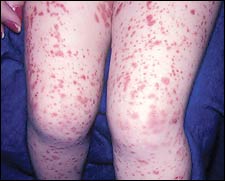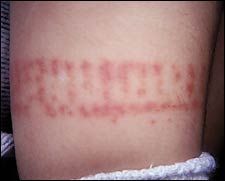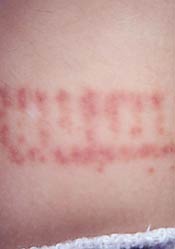A 5-year-old girl with fever, pain
This 5-year-old girl presented with a fever, pain and swelling and pain of her knees. Her younger brother had a “cold” last week. She attends preschool. The family has no pets.
What is your diagnosis?


Answer
![Patricia A. Treadwell, MD [photo]](/~/media/images/news/print/infectious-diseases-in-children/2008/03_march/treadwell_70_90_36311.jpg)
Patricia A. Treadwell, MD, is Professor in the Department of Pediatrics, Indiana University School of Medicine, Indianapolis.
The diagnosis is Henoch-Schönlein Purpura (HSP) syndrome. HSP is a hypersensitivity reaction that typically follows an infection. The preceding infection may be streptococcal or viral.
The clinical findings in HSP are petechial or purpuric lesions that are distributed in an acral pattern, most often affecting the lower legs and buttocks. “Palpable purpura” is a term that describes violaceous nonblanching raised papules. On occasion, the lesions can become vesicular or bullous. Infants tend to have more involvement of the face and scalp with accompanying edema. Lesions in areas of pressure (eg, from socks or elastic bands) may produce a pattern similar to the pattern of whatever is producing the pressure on the skin.
Noncutaneous findings include arthralgias and/or arthritis and gastrointestinal abnormalities (abdominal pain, vomiting, bloody stools). The vasculitic process can affect the kidneys and cause nephritis.
A biopsy of a petechial lesion shows a leukocytoclastic vasculitis with extravasated red blood cells. When direct immunofluorescence testing is performed, IgA immune complexes may be demonstrated.
Differential diagnoses include other vasculitic processes, juvenile arthritis, Rocky Mountain spotted fever, which is also a vaculitic disorder and meningococcemia. The lesions in meningucocenic can be similar in appearance to HMS but the distribution is concentrated on the trunk. Children who have meningococcemia are also more ill appearing.


Therapeutic recommendations are elevation of affected areas and anti-inflammatory medications. The urine should be examined for hematuria. If any evidence of renal disease exists in the acute stages of the disease, the renal status should be monitored.
There has been controversy regarding the efficacy of corticosteroid use, however, a recent meta-analysis was published. Weiss et al concluded: “Corticosteroids, given early in the course of the illness, seem to produce benefits for several major clinically relevant Henoch-Schönlein purpura outcomes.”
For more information:
- Butani L, Morganstern, BZ. Long-term outcome in children after Henoch-Schonlein purpura nephritis. Clin Pediatr. 2007;46:505-511.
- Chan KH, Tang WY, Lo KK. Bullous lesions in Henoch-Schönlein purpura. Pediatr Dermatol. 2007;24:325-326.
- Dillon MJ. Henoch-Schönlein purpura: recent advances. Clin Exp Rheumatol. 2007;25(1 suppl 44):S66-S68.
- Weiss PF, Feinstein, JA, Luan, X, et al. Effects of corticosteroid on Henoch-Schönlein purpura: a systematic review. Pediatrics. 2007;120:1079-1087.
Spot the Rash is a monthly case study featured in Infectious Diseases in Children designed to test your skills in pediatric dermatology issues.
